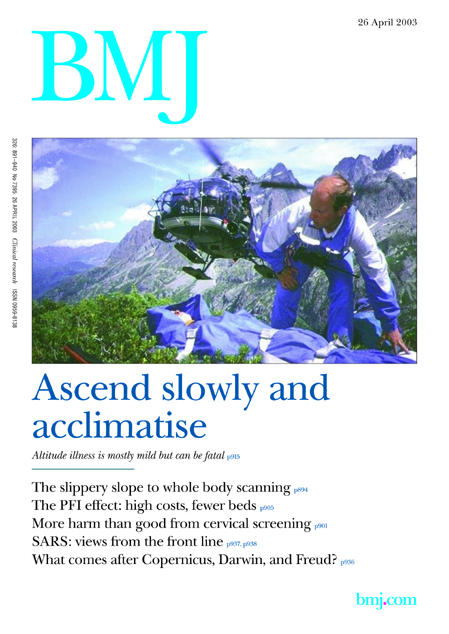Editor—Barry and Pollard reviewed altitude sickness.1 Tibetans and Sherpas (of Tibetan origin) have better physical performance at high altitude than white people,2 possibly because of genetic differences.3 Acute adaptation to high altitude and low oxygen supply is primarily by hyperventilation, which both improves oxygen saturation and increases blood pH. The capacity to correct respiratory alkalosis is thus crucial for acute adaptation to high altitude.
Figure 1.

During a hiking tour at high altitude (Mount Kailash, Tibet) we measured partial oxygen pressure in nine white Austrians (4 men and 5 women, aged 43–62 years) and seven Sherpas (5 men and 2 women, aged 28-62 years). Preadaptation periods and physical fitness in both groups were about the same before the test was performed. Basal oxygen saturation was measured at rest and during one minute of forced hyperventilation at altitudes of 5100 m and 5600 m with a small portable transdermal pulse oximeter.
Sherpas had significantly lower resting oxygen saturation, but on hyperventilation they were able to raise their oxygen saturation up to over 90%, whereas the white climbers had higher basal oxygen saturation and a significantly lower capacity to raise this. In both groups the increase in oxygen saturation over baseline values (hyperventilation capacity) was significantly lower at 5600 m compared with the hyperventilation capacity at 5100 m. Subjects with a hyperventilation capacity < 5% at 5100 m showed mild signs of acute altitude sickness, such as headache, dyspnoea, and subcutaneous oedema, when they ascended to 5600 m, whereas those with a hyperventilation capacity ≥ 5% at 5100 m had no complaints.
We conclude that hyperventilation capacity decreases with increasing altitude, and its measurement might be a suitable approach to predict the development of altitude sickness.
Competing interests: None declared.
References
- 1.Barry PW, Pollard AJ. Altitude sickness. BMJ 2003;326: 815-9. (26 April.) [Google Scholar]
- 2. Chen QH, Ge RL, Wang XZ, Chen HX, Wu TY, Kobayashi T, et al. Exercise performance of Tibetan and Han adolescents at altitudes of 3,417 and 4,300 m. J Appl Physiol 1997;83: 661-7. [DOI] [PubMed] [Google Scholar]
- 3.Beall CM, Blangero J, Williams-Blangero S, Goldstein MC. Major gene for percent of oxygen saturation of arterial hemoglobin in Tibetan highlanders. Am J Phys Anthropol 1994;95: 271-6. [DOI] [PubMed] [Google Scholar]


